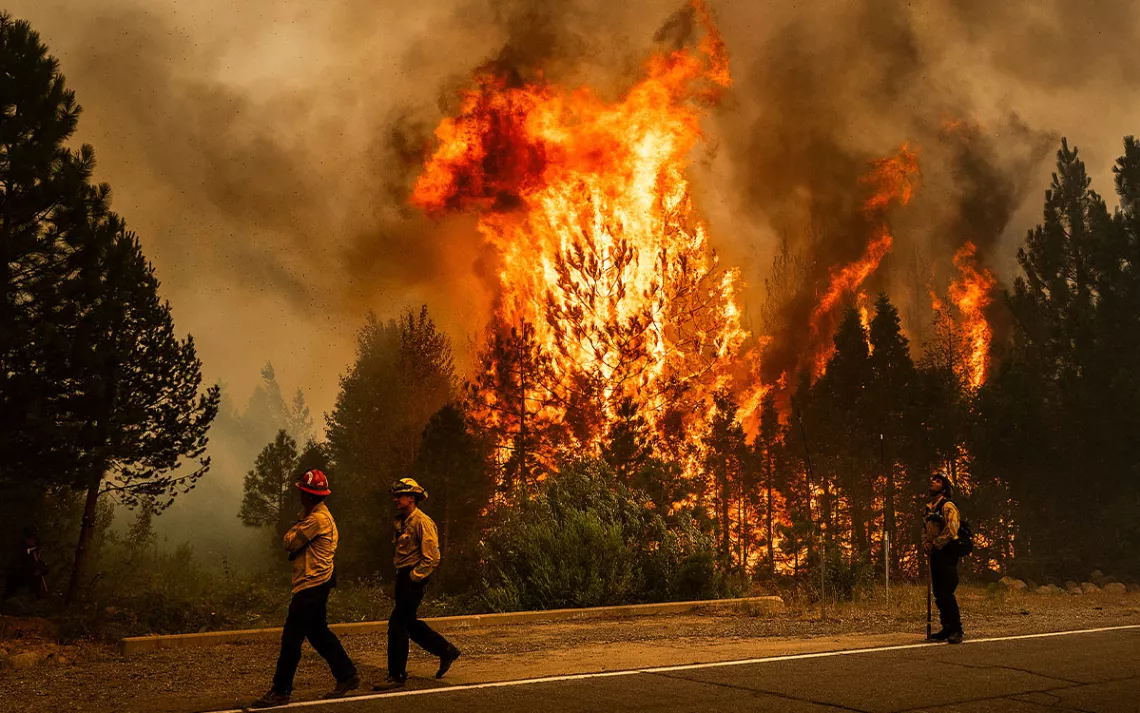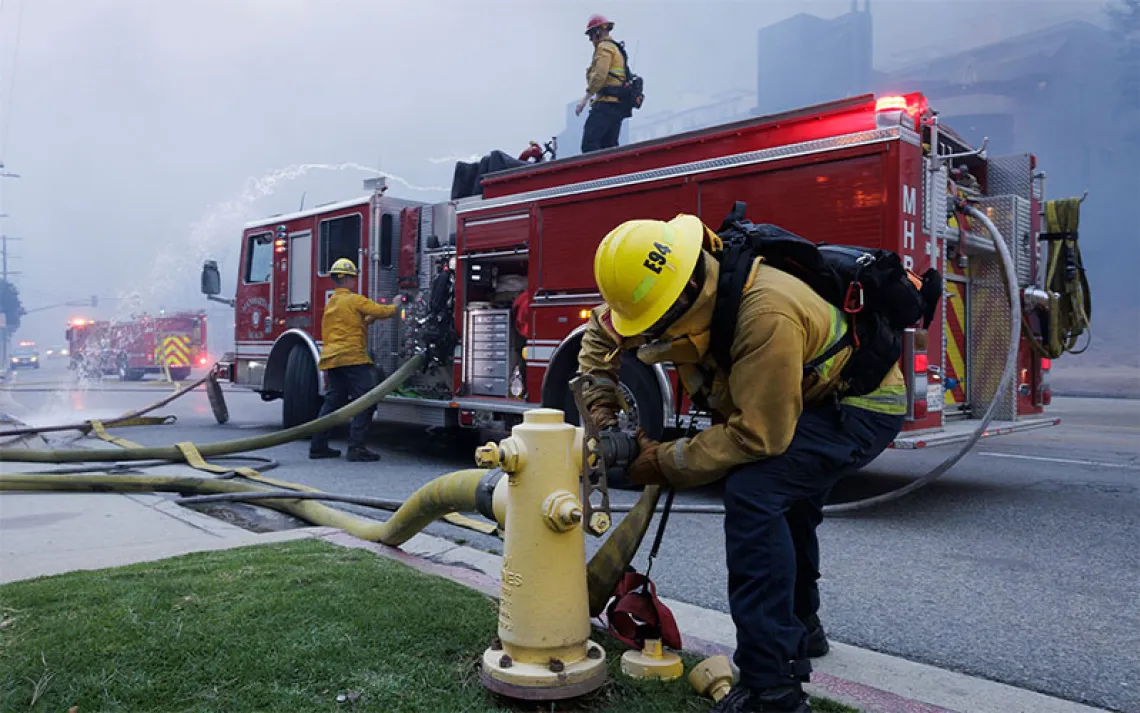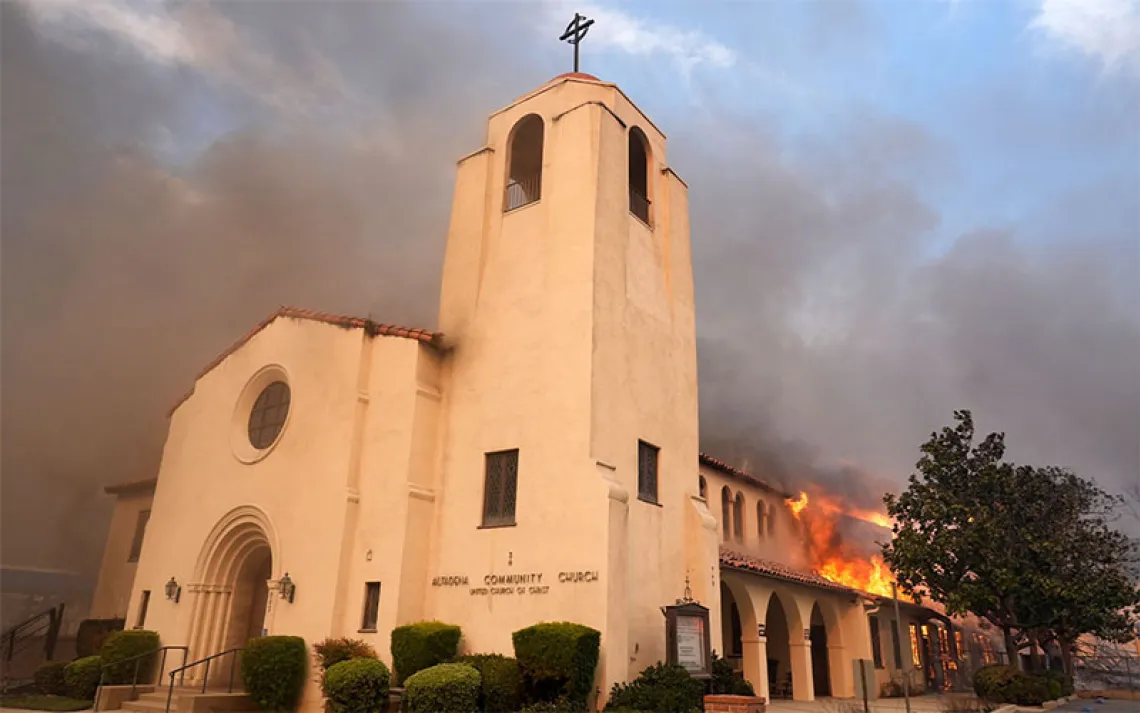Beautiful Country Burn Again
The Park Fire, the Camp Fire, and the trauma of repeated climate disaster

The Park Fire burns along State Route 172 in the Mill Creek community of Tehama County, California, August 7, 2024. | Photo by Noah Berger/AP Photo
On a Friday evening in late July, I sat perspiring on a wooden chair in a coffee shop. Nearly 30 weeks pregnant, I was always overheated, and sweat began to saturate my yoga pants, forming a wet mark beneath me like a damp photocopy of my backside.
This was the monthly convening of the “Literary Ladies” book club, and as we discussed the novel of the moment, something beyond the plate glass caught my eye. A familiar but arresting appearance in the upper atmosphere, smudged and billowing, growing by the minute.
Smoke.
We met in a Starbucks in Redding, California. Some 50 or 60 miles away, the Park Fire ripped and roared, gnawing northward, producing that telltale bruise and boil of burned matter that began to fill the sky, ominous as a mushroom cloud. The wildfire had ignited two days earlier, July 24, when a local man pushed a burning car down an embankment in Bidwell Park, outside Chico. Thanks to a heat wave that had punished California throughout July (along with dense fuels, winds, and other factors), the Park Fire grew with an explosive rate of spread, consuming over 350,000 acres within three days. It was still far away—but, considering how quickly the fire had grown, not quite far enough for comfort.
Redding had been hit hard by the 2018 Carr Fire, which burned more than 229,000 acres, destroyed over 1,000 homes, generated a “firenado,” and jumped the Sacramento River, entering the city itself and prompting the evacuation of more than 38,000 people. Eight people lost their lives, several of them wildland firefighters. Almost everyone around the table was touched by the fire, whether by heavy smoke, evacuation, losing a home, or knowing someone who had. Even seeing a beloved landscape demolished and blackened is a vision that can be tough to forget.
So, noticing smoke outside the window, the women around me admitted they were nervous. And, faces turning haunted, they began to share their memories.
“We were trying to evacuate. The gas stations were mobbed, but they were all out of gas. The sky was black.”
“The sky was dark, but it was also orange. Ash was raining down on us. I remember ash covering the hood of the car like dust.”
“I could see the fire coming down the hill behind the houses, and I was like, ‘We have to get out of here.’”
I wasn’t in Redding when the Carr Fire happened, but I know these stories all too well. For one, I lived in a town (Happy Camp, California) that was half-leveled by a catastrophic fire in 2020. For another, I used to work as a federal wildland firefighter, where I witnessed hundreds of thousands of acres of forest go up in smoke; saw burned vehicles and incinerated animals; watched communities catch fire; lit the forest around homes in a last-ditch attempt to save them from oncoming flames; saw burned trees fall and injure my coworkers.
I’ve lived these moments—the slow-motion panic, the chaos, the fear—from both sides, as local resident and first responder. Some people who’ve seen what I’ve seen get used to it. I never have.
Back at home, I opened a fire-tracking app and took a rough measurement of the distance between the fire’s perimeter and our neighborhood in West Redding. It wasn’t that close, the terrain flattened near town, and winds seemed to be pushing away from us, to the northeast. I decided not to worry (much) or pack a bag (yet).
For people in the town of Paradise, though, it was a different story.
*
Steve McFarland and his family survived the 2018 Camp Fire in Paradise, California, the deadliest wildfire in California history. McFarland’s son, who was five years old at the time, witnessed burning buildings and heard explosions as they raced out of town. Their home survived the blaze, but several years and a protracted battle with the insurance company later, they relocated to Magalia, about 20 minutes north of Paradise.
McFarland said they faced a choice about whether to keep living in a beautiful yet fire-prone area. They chose to stick it out; Steve’s wife is an RN, while Steve is a stay-at-home dad who manages their rural property and the small band of pack llamas they use to escort hikers into the wilderness. Their devotion to a homesteading lifestyle, they decided, was stronger than their fear of another fire.
But they were committed to being prepared: the family cleared and thinned much of the forested acreage on their new property, created defensible space, replaced vents, and installed a metal roof on their home. As McFarland, who worked as a Forest Service firefighter years ago, puts it, “If you’re not prepared to do the work [of getting fire-ready], then you probably shouldn’t be living up here.”
He’s afraid his take may sound harsh, but to me it seems realistic, pragmatic. Because it’s not a question of whether wildfire will revisit this area but when. In the six years since the Camp Fire, residents of Butte County have faced close calls and/or evacuations from the Bear, the Dixie, the North Complex, and smaller blazes. “It’s been constant,” McFarland said. “If you look at a map, these fires are all occurring on top of each other.”
Indeed, if you visit the CalTopo map builder and choose a location—say, Paradise—then toggle “fire history,” what you see might come as a shock: layered fires overlapping one another like multicolor blotches of spilled ink, leaving hardly any land untouched. A recent map series and story shows the four fires that burned nearly 40 percent of Butte County in the last decade. But other counties fared worse in total area burned. Trinity County, torched by a large share of 2020’s million-acre August Complex, has seen 50 percent of its land burned in the last 10 years, while Plumas and Lake Counties have each lost over 60 percent. People who live in these regions have seen and will continue to see wildfire almost every year.
“Beautiful country burn again,” the poet Robinson Jeffers wrote. “Burn as before with bitter wonders.”
*
This July, from their home in Magalia, McFarland’s now-11-year-old son saw the flames of the Park Fire cresting a ridge less than 14 miles away. Remembering, surely, what he’d endured as a five-year-old, the boy lost it.
“He was freaked out of his mind,” McFarland says. “He was asking me, ‘Are we gonna burn up and die?’”
He wasn’t the only one feeling scared. Wildfire survivors from Chico to Paradise to Magalia and beyond smelled the smoke—saw the column—and panicked. “It initiated a huge frenzy in the community,” McFarland says. Some people prepared to stand their ground, while many grabbed their bags and left before the evacuation warning became an order. Universal among the survivors was a profound sense of fear—and anger.
Their reaction is understandable. The Camp Fire caused an unprecedented amount of destruction—over 13,500 homes, the first time a wildfire had basically wiped a town off the map—and created scenes worthy of a horror movie. Eighty-five people perished, making it by far the most deadly blaze in California history (the next most deadly claimed 29 lives). And the recovery process has been profoundly challenging; many people remain locked in a battle over fire insurance to this day and have yet to rebuild their homes. Some people lost their homes in the Camp Fire, rebuilt, and lost their homes again to the Park Fire this past month.
Among those physically untouched by the Park Fire’s now-sprawling 429,000 acres of damage, the psychological impact of previous fires endures.
McFarland says his son isn’t alone in seeming shell-shocked; the children of Paradise, he points out, suffered losses in the fire that were then compounded by the stress and isolation of the pandemic—followed by more fire. “It was just trauma, trauma, trauma.” While McFarland and his family went to therapy and are doing better now, other families didn’t fare as well. “Divorces happened following the fires. Kids hate their parents. People have separation anxiety because they were separated during the fire … everyone is scarred. Some people have turned to drugs and alcohol. Families have fallen apart. Some have learned to cope, but some still aren’t coping.”
McFarland is quick to add that Paradise was inundated with help and support following the fire, that the community has bounced back in many ways, and that tragedy brought people closer together. “There’s a lot of help out there,” he says. “There’s been an abundance of support.” And he points to the generosity of spirit than can arise from enduring a disaster, like the Camp Fire survivors who came together to help victims of the Park Fire.
But while some people may avoid counseling and other services offered, some try it and find it doesn’t work. Years later, many survivors continue to struggle. Then along comes a new threat, another fire, and they feel it all over again.
“Some people,” McFarland says, “aren’t ever gonna get over it.”
*
According to Dr. Emily Diamond, this is normal. “There’s a ceiling on resilience,” she says, expressing frustration that amid the pop culture conversation about “raising resilient kids,” people might forget that even resilience has limits.
The first time a person goes through a disaster, they might suffer but bounce back quickly, say in three to six months. The second or third time, however, a person might be slow to recover, or they might not return to “normal” at all. Diamond, a clinical psychologist and professor at the Wright Institute in Berkeley, studies pain. She and her colleagues are conducting a series of “nested” studies on pain, trauma, and the impacts of natural disasters. One out of five people in this country is in pain, Diamond says, and one in three veterans. Adults who endured a natural disaster as a child are far more likely to suffer from physical pain as an adult.
A disaster like a wildfire is “a biopsychosocial event,” Diamond says. “The psychological harm and the physical harm are one.”
When Paradise burned in the Camp Fire, a huge amount of lead was discovered in the smoke, along with manganese, which is toxic to the brain. Hence, fire survivors were both emotionally devastated and physically poisoned. Even without high levels of lead, wildfire smoke impacts the brain and our psychology. Dr. Joshua Wortzel, chair of the American Psychiatric Association’s Committee on Climate Change and Mental Health, says research is conclusive that the airborne pollutants in wildfire smoke (PM 2.5, ozone, and methane, among others) impact mental health across the board. Wortzel, also a faculty member at the Institute of Living and Yale University Department of Psychiatry, says that smoke exposure harms people at every age.
Fetuses of mothers exposed to wildfire smoke show a higher risk of intrauterine growth restriction, preterm birth, and lower birth weight; children who breathe smoke may face developmental delays and higher incidences of autism, ADHD, and behavioral disorders; adults exposed to smoke have higher rates of depression, suicide, bipolar disorder, and violent behavior; and older people show an increased risk of dementias when they’ve been exposed to smoke.
While Wortzel says these are “general associations” that may be impacted by social and medical history, “The evidence is pretty damning.”
Diamond is especially concerned about children, who develop asthma at much higher rates in areas with heavy wildfire smoke. There is a demonstrated correlation between smoky days and increased school absences, and kids who survive a disaster may struggle academically long-term. At the same time, children are grieving.
Our job as adults, says Diamond, is to “make children fall in love with the world.” But in the face of climate change and escalating disasters, “children’s love may be mixed with fear—and a new vigilance that isn’t going to go away. We may have to witness more mourning than we ever wanted in our children’s lives.”
What is to be done? If a town like Paradise were flooded with support and access to therapy, is that enough?
Diamond says no. In one study, when trauma survivors were given access to mental health care, about half tried it out—but 20 percent of those people left disappointed, saying the care “didn’t work.” “We have to up our game,” Diamond says. We need better ways of understanding what the problems are. We need providers who are well-versed in disaster trauma (and in the case of first responders, therapists educated to understand their workplace culture and challenges), and less siloing of professions, says Diamond. Medical doctors, alternative practitioners and psychologists need to work together to provide integrated care, because disasters affect survivors’ minds and bodies at once.
Research into climate change (and by extension, climate-driven natural disaster) mental health issues is “an emerging space,” says Wortzel. As such, it’s important that funders invest in research in these fields, so doctors and scientists can be prepared to face the inevitable explosion of climate-related distress, anxiety, depression, anger, illness, and grief that are certain to accompany life on a warming planet.
And we must have realistic expectations about what a new normal looks like, says Diamond. “If someone has been through a fire and they smell or see smoke, and they get very nervous, that’s a normal response. It would be strange not to be afraid. We need to stop expecting people to just be OK or bounce back immediately. We need to be much kinder and gentler with each other.”
*
By the end of our chat, I’m calling Diamond “Emily” and talking to her like a long-lost aunt. She tells me that I should get an air filter to use during pregnancy, and I promise to do so. Then she adds one more fact. She says that children and first responders share a problem: “They cannot get away from the thing that they fear.”
Kids have to go along with riding out a storm or continuing to live in a town that burned, because they have no choice. And firefighters are repeatedly exposed to the same risks and triggers because that’s their job. This inability to get away from what frightens us can compound trauma responses over time.
I know this. I feel this. It hits close to home.
Wortzel gives me a double take too. High levels of exposure to wildfire smoke in rural communities, he says, have been shown to increase rates of suicide. Immediately I think of wildland firefighters, who inhale more smoke than anyone else, and whose rates of death by suicide threaten to outpace military veterans'. I always assumed this was due to psychological trauma and PTSD from the job. Now I wonder: What if it’s also the smoke?
“How much is trauma and how much is driven by biological factors?” Wortzel asks. The data can be challenging to parse.
Looking at a list of the largest fires in California history, I notice that in my two years as a wildland firefighter, I fought three of the top 10: August, Dixie, North. The 15th largest, the Monument Fire, is where I saw a tree fall on my colleague and thought he was going to die. Unlike others, I’m not too frightened by a smoke column. But I’m scared of what comes later.
*
By mid-August, when I sit down to write this, the Park Fire almost seems like old news—at 50 percent containment, there’s a stale feeling to both the acreage updates and the images of smoldering earth. But the smoke is new—or rather, its presence has renewed after a week’s reprieve.
I wake early; I’m 32 weeks pregnant and not sleeping well. When I leave the house, headed for Whiskeytown Lake with the dog, I can taste it: The smoke is heavier than yesterday. It settles in, a white curtain obscuring the mountains. I shorten the dog’s hike, striking a balance between our mutual need for exercise and my terror of early labor; I can’t get that correlation with preterm birth out of my head.
Panting as I climb a small hill, the taste of wood smoke still calls up what it suggested when I fought fire: excitement, nerves, a meaningful job to do, the gratification of hard labor—and, if I’m perfectly honest, money. I feel the old thrill for a split second before remembering how bad this is for me now. How bad this is for all of us.
I am no longer afraid that the Park Fire will rip westward and burn down our home, turning to ashes the room recently outfitted with crib and changing table and stack of burp cloths. The biggest threat subsided within the fire’s early days. But I can’t help thinking of the women who were pregnant when the Camp Fire blew up, can’t help remembering the dogs with burned paws and the houses reduced to mounds of smoking rubble in Happy Camp. Now that I’ve heard more stories from Paradise, I can’t stop picturing the parents stuck at work as their children rode through the fire on a school bus. These stories pile on my own memories, a mental scrapbook of fear and grief, an album of fire.
We move on, of course. But we can’t quite forget—and maybe forgetting isn’t the answer.
Like me, Steve McFarland noticed the tendency of wildfire survivors to spontaneously launch into their stories. After the fire, he says, “People would just unload on me—sometimes it was really dark stuff.” But McFarland didn’t mind.
“I think that’s healthy. If people can talk it out, then it just becomes a story. Maybe that’ll help them to feel better and, eventually, leave it more in the past.”
 The Magazine of The Sierra Club
The Magazine of The Sierra Club



